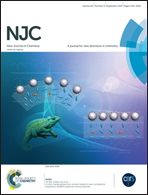Cycloaddition of alkynes to diimino Mo3S4 cubane-type clusters: a combined experimental and theoretical approach†
Abstract
A heterocyclic ligand 4,4′-di-tert-butyl-2,2′-bipyridine (dbbpy) has been coordinated to the Mo3S4 cluster unit affording the complex [Mo3S4Cl3(dbbpy)3]+ ([1]+) in a one-step ligand-exchange protocol from [Mo3S4(tu)8(H2O)]Cl4·4H2O (tu = thiourea). The new cluster was isolated as [1]PF6 and [1]Cl salts in high yields and the crystal structure of the latter determined by X-ray analysis. The synthetic procedure was extended to tungsten to afford [W3S4Cl3(dbbpy)3]+ ([2]+). Kinetic and NMR studies show that [1]+ reacts with several alkynes to form dithiolene species via concerted [3+2] cycloaddition reactions whereas [2]+ remains inert under similar conditions. The different rates for the reactions of [1]+ are rationalised by computational (DFT) calculations, which show that the more electron-withdrawing the substituents of the alkyne the faster the reaction. The inertness of [2]+ is due to the endergonicity of its reactions, which feature ΔGr values systematically 5–7 kcal mol−1 more positive than for those of [1]+.


 Please wait while we load your content...
Please wait while we load your content...